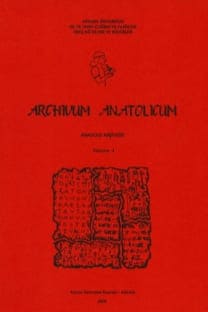Kültepe Metinlerinde Geçen Ṣiparātu(m) Sözcüğü Üzerine Bir Değerlendirme
Anadolu’nun en eski yazılı belgeleri
Asur Ticaret Kolonileri Çağı’na aittir.
Bu çağa ait belgeler, Eski Anadolu’nun ticaret ve buna bağlı gelişen
kültürel yapı ile zenginleşen tarihinin aydınlatılmasında kılavuzluk etmiştir. Kültepe’de
ele geçen Asurlu tüccarların kişisel arşivleri, o dönem Anadolu-Asur arasındaki
ticarî ilişkileri konu alan çok sayıdaki belgeden oluşmuştur. Bu belgelerde
geçen ve ne olduğu netleştirilememiş bazı sözcükler bulunmaktadır. ṣiparātum bu
sözcüklerden biridir. Bu çalışmada, ṣiparātum sözcüğünün ne için kullanıldığı,
kelimenin etimolojisi, geçtiği metin yerleri ve birlikte kaydedildiği diğer
ticarî mallar değerlendirilerek
bir sonuca ulaşmak amaçlanmıştır.
Anahtar Kelimeler:
Eski Anadolu, Kültepe Tabletleri, iğneler, kanca
A Commentary on ṣiparātum Word Recorded in Kültepe Tablets
Anatolian’s oldest written documents belong to the Assyrian
Trade Colonies Period. This ancient history of Anatolia which was
enlightened with the help of these documents, has been enriched by
trade and cultural structure. Personal archives of Assyrian merchants
that found in Kültepe are composed of a large number of documents
about trade relations between Anatolia and Assyria in that period.
The meanings of some words that were used in these documents have
not been identified yet. ṣiparātum is one of these words. The aim of
this study is to focus on the etymology of the word, places in the text
where it is mentioned and the names of other trading goods with
which it is collocated in order to find out the meanings of the word .
Keywords:
Ancient Anatolia, Kültepe Tablets, bronze pins, buckle,
___
Bilgiç 1940: E. Bilgiç, “Asurca Vesikalara Göre Etiler den Önce Anadolu da Maden Ekonomisi” Sümeroloji Araştırmalar, AÜDTCF Yayınları, Cumhuriyet Matbaası, Ankara.Dercksen 1996: J. G. Dercksen, The Old Assyrian Copper Trade in Anatolia, İstanbul.
_______ 2004: Old Assyrian Institutions, Nederlands Instituut Voor Het Nabije Oosten.
Günbattı 2011: C. Günbattı, “Anadolu’nun Politik Manzarası”, Arkeo-Atlas No: 2011/01 İstanbul.
______ 2012: Kültepe-Kaniş Anadolu’da İlk Yazı, İlk Belgeler, K.B.B.K.Y. Kayseri.
Larsen 2010: M.T. Larsen, Kültepe Tabletleri VI-a, TTKY, Ankara.
______ 1994: “Eski Asur da Kervan Dökümleri”, Nederlands Historics Archaeologisch Institutut, İstanbul.
Lewy 1958: J. Lewy, “Aspect of Commercial Life in Assyria and Asia Minor”, JAOS 78.
Özgüç 1986a: T. Özgüç, Kültepe-Kaniš II, Eski Yakındoğu’nun Ticaret Merkezinde Yeni Araştırmalar, T.T.K.Yayınları, VI-41, Ankara.
______ 2005: Kültepe-Kaniş, YKY, İstanbul.
Veenhof 1972: K.R. Veenhof, Aspects of Old Assyrian Trade and Its Terminology. Leiden.
_______2010: Kültepe Tabletleri V, TTKY. Ankara.
Yıldırım 2006: N. Yıldırım, “Kültepe Tabletlerinde Geçen dulbātum Kelimesi”, Archivum Anatolicum Cilt. 9, Sayı 1, Ankara.
AHw: W. Von Soden, Akkadisches Handwörterbuch, Wiesbaden 1965-1981.
BIN 4: A.T. Clay, Letters and Transactions from Cappadocia, New Hawen 1927. BIN 6: F.J.Stephens, Babylonian Inscriptions in the Collection of J.B. Nies VI, New Haven 1994.
CAD: The Assyrian Dictionary of theUniversity of Chicago 1956vd.
CCT 1: Cuneiform Texts from Cappadocian Tablets in the British Museum, London 1921.
CDA: J. Black, A. George, N. Postgate, A Concise Dictionary of Akkadian, Harratzowitz Verlag 2000.
ICK 1: M. David, Inscriptions Cunéiforms du Kültepe, Paris 1952.
KTHahn: J.Lewy, Die Kültepe Texte aus der Sammlung Frida Hahn, Berlin 1930.
KTS: V. Donbaz, Keilschrift texte in den Antiken Museen zu Stambul II, 1989.
OIP 27: J.Gelb, Inscriptions from Alishar and Vicinity Chicago 1935.
TC 2: F. Thureau-Dangin, TablettesCappadociennes deuxiemeserie, MuseeduLouvre Paris 1928.
- ISSN: 1300-6355
- Yayın Aralığı: Yılda 2 Sayı
- Başlangıç: 1995
- Yayıncı: Ankara Üniversitesi
